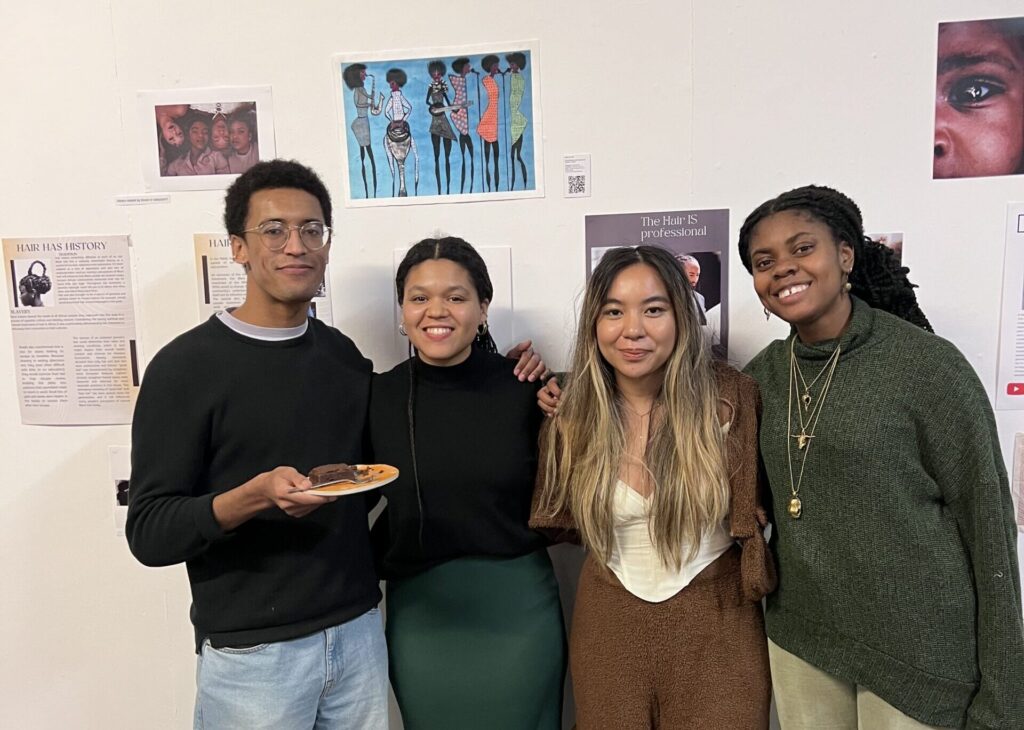Student Anthony Lynch, one of the organisers of the In-Between Lines project at Coram, explains what it is setting out to achieve.

In-Between Lines explores the experiences of family, growing up, and finding identity through the lived experience of adoption and mixed-race heritage. Specific themes that we are exploring over the course of the project at Coram (1-6th April) include colourism, hair, home, healing from trauma, and beauty. The project consists of a free display of art, text, and audience prompts, with several live events exploring the above themes in greater detail.
Why In-Between Lines? Since I was a child, I’ve always felt disconnected from my identity. My adoption severed me from my biological family—to look in the mirror and see your father’s face in yours is something a lot of people take for granted. Likewise, my mixed-race identity resulted in me feeling neither white nor black enough for either community. A combination of both resulted in separation from my ancestral roots: my DNA test in 2020 highlighted Togo, Benin, and Nigeria, rather than the Jamaica I had expected. To be clear, my biological Grandmother is a proud member of the Windrush generation. Yet, for biology and colonial reality to be an ocean apart, and to be reminded of the recency of slavery, left me feeling resentful and alone.
Over the years, I’ve struggled with feelings of anger, rage, and grief, but anxiety has always been my constant companion. Cognitive Behavioural Therapy models anxiety as ‘’intolerance of uncertainty’’. My adoption and racial identity generate precarity: not knowing how people will perceive me, what my biological family looks or sounds like, or whether my darkest days were benign or a terrible repetition of my family’s mental health history. Years of therapy helped, but it couldn’t heal the existential angst that a lack of identity creates. I felt so lost, and eventually I realised that I’d have to find a life narrative that served me.
Some people are confused about why it’s both perspectives, but the adopted and mixed experiences share several similarities. Firstly, they are niche, but growing communities in Britain. Secondly, they have structural features that can involve trauma, compromising one’s identity, and lacking belonging, but also have special insight into society, race, and family. Thirdly, their narratives in mainstream culture are overly negative and written by those without lived experience, which reproduces negative outcomes by limiting what these individuals feel capable of. The few represented in the media only embody a narrow slice of the mixed and adopted experience, with less ”glamorous” perspectives marginalised. We feel that our lived experience can give a realistic account of the challenges and opportunities that adoption and mixedness provide, while also providing a space for people to explore their own journey free from societal stereotypes and prejudice.
For me, In-Between Lines exemplifies the importance of connecting across difference, exemplifying writer and feminist Audre Lorde’s insight that that difference doesn’t have to be painful but instead can be a source of creation. Everyone has feelings of loneliness, vulnerability, authenticity, and belonging–they are part of being human. We share our labels not to set us apart, but to welcome people into our particular experience of those feelings. The project is fundamentally inclusive and we welcome those who don’t have our intersections yet still want to learn and engage.
When the display is up, I feel free to be my messy, uncertain self. For example, I’ve always had a difficult relationship with my hair, but in my exhibition, I feel safe to keep it unkempt. Emmanuel Onapa writes that the hair is a site of identity and declaration of selfhood. I’m not quite there yet—I’ve been busy working through other things—but at In-Between Lines, I don’t need to be. More generally, I feel empowered to hold both the suffering I’ve experienced, with the joy that being alive and learning from my challenges has brought me. I know that others with overlapping experiences to mine have finally felt seen, and I want to share that feeling with as many people as I can.
Our immediate aim with In-Between Lines was to create a space for adopted and mixed individuals to feel safe and heard. The display will validate their experiences and enable them to contribute their own thoughts surrounding mixed and adopted narratives. For those who don’t have these intersections, we want to provide them with the language and concepts to confidently engage with mixed and adopted individuals, as well as to inspire thoughts about how their own upbringing and societal narratives contribute to their identity. The long-term goal is to form an online community of mixed and adopted creatives who can tell their stories through writing, art, photography, film, and more.
Working out my identity and purpose has felt really tough at times, but thanks to my hard work and the kindness of others, I finally feel in a place of knowledge and peace. I’m really excited and grateful to Coram for the opportunity to showcase our experiences in such a vibrant, diverse place as London. Thank you for reading, and if you want to find out more, we are available at @Inbetweenlinesexhibition on Instagram. Hope to see you at an event soon!
Anthony Lynch is a 23-year old Part-time Master’s Student at King’s College London. His heritage is Jamaican-English, and he was adopted to a mixed-race family at 20 months.
